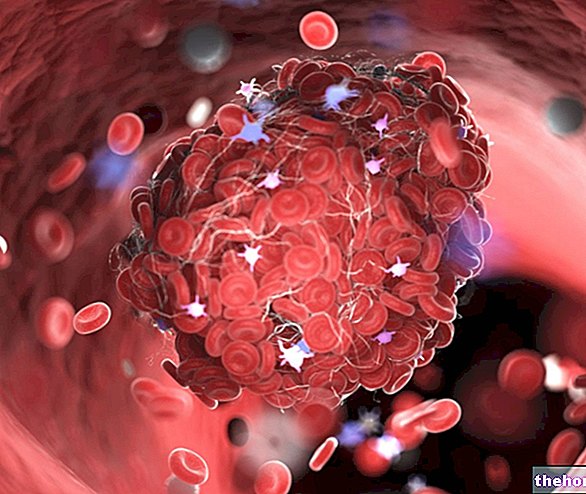Generality
Apoplexy is a pathological condition characterized by a sudden hemorrhage, which occurs in correspondence with a specific tissue or organ causing serious alterations and causing its destruction.

However, it should be remembered that the stroke - in addition to being of the haemorrhagic type - can also be of the ischemic type, ie it can be caused by a drastic reduction or by the lack of blood flow in the brain.
However, by extension, the term apoplexy is also used to indicate other pathological conditions characterized by a "sudden hemorrhage, with consequent loss of functionality of the affected tissue.
Types of Apoplexy
Since the term apoplexy is used to indicate particular pathological conditions, characterized by loss of functionality of the affected area following sudden haemorrhage, different types of apoplexy can be distinguished according to the body district concerned.
Among the most known types of apoplexy and which will be treated in this article, we remember:
- Brain apoplexy (stroke);
- Pituitary apoplexy;
- Utero-placental apoplexy (also known as Couvelaire's syndrome, or Couvelaire's uterus).
Causes
As mentioned, apoplexy is characterized by a sudden hemorrhage, which causes damage to the affected tissues and organs.
The causes triggering the aforementioned haemorrhage are usually to be found in disorders, alterations and compromises of the cardiovascular system, however, these factors can vary greatly depending on the type of apoplexy in question.
In the case of cerebral apoplexy, the main causes that cause its onset are: aneurysms, chronic hypertension, congenital arteriovenous malformations and brain trauma.
Pituitary apoplexy, on the other hand, is caused by the presence of a pituitary adenoma; however, the exact mechanism leading to the onset of hemorrhage is not yet fully understood. Some believe that the apoplexy in question may be caused by an increase in the size of the adenoma, which compresses the structures adjacent to it, causing various damages.
Utero-placental apoplexy, on the other hand, consists of a serious form of untimely placental abruption, a complication of pregnancy in which there is a partial or total detachment of the placenta from the uterus, before the birth is completed. The cause of this detachment could be of a traumatic nature, or it could be the consequence of other pathologies from which the pregnant woman suffers.
Diagnosis
Naturally, the tools used to diagnose a possible apoplexy can vary according to the type of apoplexy to be identified.
In any case, we can affirm that the main diagnostic tools used for the identification of this pathological condition are:
- Blood tests to evaluate a set of factors, such as complete blood count, blood sugar, serum electrolytes, transaminases, bilirubin, prothrombin time, etc;
- Ultrasound;
- Electrocardiogram (in particular, in case of cerebral apoplexy);
- Magnetic resonance.
Symptoms
Similarly to what happens for the causes triggering the apoplexy, the symptoms can also vary according to the type of bleeding that occurs.
The characteristic symptoms of cerebral apoplexy consist of:
- Difficulty walking
- Difficulty of speech;
- Visual disturbances;
- Headache;
- Paralysis and / or numbness of the face and limbs.
The typical symptomatology of pituitary apoplexy, on the other hand, consists in the onset of:
- Headache located behind the eyes and temples;
- Nausea and vomit;
- Visual disturbances.
In association with the aforementioned symptoms, sometimes, neck stiffness, photophobia, decreased state of consciousness can also occur. It should also be remembered that patients affected by pituitary apoplexy often have a deficit in the secretion of adrenocorticotropic hormone and cortisol (probably caused by the "pituitary adenoma), which can lead to circulatory collapse.
Finally, in case of utero-placental apoplexy, the affected patients may present symptoms, such as:
- Continuous uterine contractions;
- Vaginal bleeding which can be of varying intensity;
- Hypotension;
- Tachycardia;
- Shock.
Of course, in this particular form of apoplexy, there is also considerable suffering of the fetus.
Treatment
The therapeutic strategy that is decided to undertake varies according to the form of apoplexy to be treated.
In the case of cerebral apoplexy, first of all, it is necessary to stop or in any case control the loss of blood by administering special coagulating drugs. Furthermore, if the bleeding has been conspicuous, it may be necessary to remove the leaked blood, in order to prevent it from generating pressure in the brain. After that, the patient is usually observed.
Furthermore, depending on the triggering cause of the cerebral apoplexy, it may be necessary to resort to surgery.
Finally, in patients affected by cerebral apoplexy, it is essential to undergo rehabilitation, aimed at recovering all, or at least most, of the compromised and / or lost functions due to the hemorrhage itself.
Read more about the treatment of cerebral haemorrhage
In the case of pituitary apoplexy it is essential to immediately stabilize the circulatory system. Generally, we proceed with the administration of corticosteroids in high doses, to make up for the deficits presented by the patients. However, even in this case, surgery may be required. In particular, emergency surgery is required when patients experience sudden visual symptoms associated with oculomotor nerve palsy.
In case of utero-placental apoplexy - which is the most serious form of placental abruption - the doctor may first decide to perform a caesarean section to safeguard the fetus.
To stop bleeding in women, in these cases drug therapy may not be sufficient, so surgical treatment is the only available alternative.
Furthermore, in the most severe cases of utero-placental apoplexy, it may be necessary to perform the removal of the uterus (hysterectomy).




























